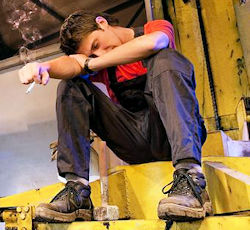People
This category refers to any employee (or others) at any level of the organization who is not "sober and focused" on the work they're doing. For example, an employee might be in a hazardous "state of being" if they are:
- under the influence of legal/illegal drugs;
- poorly trained or educated;
- worried about a family illness; or
- mentally or physically incapable of doing the job safely
Remember, an employee who is distracted in any way from the work they're doing should also be considered a "walking" hazardous condition that increases the likelihood of an unsafe behavior. Unfortunately, OSHA does not usually "catch" employees working in an unsafe manner, so you don't see unsafe behaviors described in OSHA citation reports too often.
Remember, hazardous conditions may be thought of as unsafe "states of being." All of the following situations may cause employees to be what I call "walking hazards"
- Employees are too tired to do the work without causing injury to themselves or others.
- Drugs (either legal or illegal) and alcohol place employees in altered states of awareness and lengthens reaction time.
- Employees who are distracted (internal thoughts are not focused on the work being performed). You can't be thinking about the football game while working on high voltage!
- Feeling hurried when working on a hazardous task is probably the greatest reason employees perform unsafe actions. The more hurried employees are, for whatever reason, the more likely they are going to have accidents.
Workers who take unsafe short cuts, or who are using established procedures that are unsafe, are accidents waiting to happen. Hazardous work practices represent the majority of the surface causes of all accidents in the workplace. Bottom-line: If employees are not sober and focused while working, they are walking hazardous conditions.
Systems
Every company has, to some degree, a safety management system. Management may fail to develop, perform, or deploy safety policies, procedures and rules. Management may ignore safe behaviors or actually encourage unsafe work practices. System weaknesses like these ultimately represent the causes most, if not all workplace accidents. The only exception are the rare unknowable-uncontrollable "acts of God". Examples include:
- A company policy that sets unrealistic production targets, encouraging employees to rush and skip safety procedures to meet deadlines.
- A poorly designed emergency evacuation plan that does not account for the specific layout of the workplace, leading to confusion and delays during an actual emergency.
- A safety training program that is only conducted once a year and does not include hands-on training or refreshers, resulting in employees not retaining critical safety information.
- A maintenance process that does not include regular inspections of safety equipment, leading to the use of malfunctioning or expired safety gear.
- Lockout/tagout procedures that are overly complicated and time-consuming, leading employees to bypass them and perform maintenance on live machinery.
- A practice of not enforcing the use of personal protective equipment (PPE) consistently, allowing employees to decide when and where to use it, which results in inconsistent protection and increased risk of injury.
Knowledge Check Choose the best answer for the question.
1-7. Inadequate policies, procedures, and work practices represent _____ hazards.
You forgot to answer the question!

